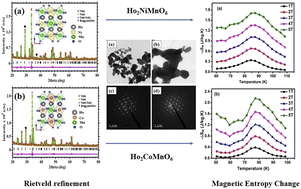Rare-earth double perovskite oxides have intriguing magnetocaloric properties at cryogenic temperatures. In this study, Ho2NiMnO6 and Ho2CoMnO6 were synthesized using the sol–gel method, which crystallized in a monoclinic structure in the P21/n space group. The magnetic phase transition was observed at 81.2 K for Ho2NiMnO6 and 73.5 K for Ho2CoMnO6. The presence of a paramagnetic matrix and short-range ferromagnetic clusters causes magnetic disorder in these double perovskites, resulting in Griffiths phase formation. The Arrott plot confirms that compounds undergo second-order phase transition. At an applied magnetic field of 5 T, the maximum magnetic entropy change (−ΔS) for the studied compounds is 1.7 and 2.2 J kg−1 K−1, respectively. The transition metals Ni and Co in a double perovskite cause lattice distortion in the structural parameters and oxidation states of manganese (Mn3+/Mn4+), which changes the magnetic and magnetocaloric properties. The quantitative approach provides a systematic study of magnetocaloric properties of the rare earth double perovskite compounds with ferromagnetic 3d transition elements.

